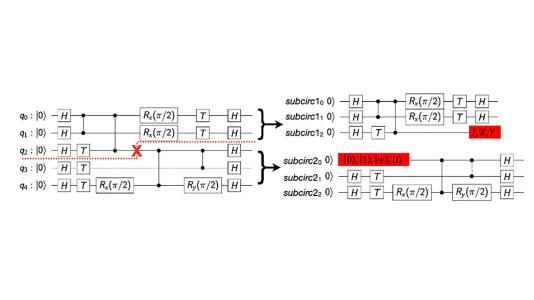
Quantum computing (QC) offers the potential to revolutionize certain computational problems. Its power derives from the fact that each additional qubit doubles the size of the computational state space available to a QC algorithm. But current noisy intermediate-scale quantum (NISQ) devices are limited to low qubit counts.
To address this situation, a team of researchers from Argonne National Laboratory and Princeton University have developed CutQC.
How it works
As the name implies, CutQC automatically locates positions to efficiently cut large quantum circuits into smaller subcircuits. These smaller subcircuits can be independently executed on smaller quantum devices, and scalable post-processing can then be performed on classical computers to reconstruct or sample the output of the original circuit (see Fig. 1).
The process may sound easy: Just cut something into smaller pieces. Two challenges arise, however. The first involves determining where to cut. Finding optimal locations is crucial to minimizing the post-processing overhead. The solution derived by the researchers is to use a mixed-integer programming (MIP) cut searcher that automates the identification of cuts requiring the least amount of classical post-processing. The second challenge is to scale the classical post-processing. The solution the researchers devised involves a dynamic definition algorithm that uses recursion to efficiently sample large circuits. Each recursion zooms in on a bin of states with the highest probability, improving its definition – without needing either a large quantum computer or vast classical computing resources.
“This hybrid approach, combining classical and quantum computing, is significantly faster than running solely on conventional platforms, and it enables scientists to evaluate quantum circuits that are far larger than can be run on either QC or classical computers alone,” said Wei Tang, a Princeton graduate student and former W. J. Cody Research Associate at Argonne’s Mathematics and Computer Science (MCS) division and lead author of a recent paper on CutQC presented at the 26th ACM International Conference on Architectural Support for Programming Languages and Operating Systems.
Industry adoption
“We are especially excited to see this approach being incorporated into the IBM Qiskit,” said Jeffrey Larson, a computational mathematician in Argonne’s MCS division and one of the coauthors of the CutQC research paper. Qiskit is a widely used open-source software development kit founded by IBM Research to allow simulation and cloud access to IBM’s quantum computing services.
Larson noted that CutQC’s innovative approach was highlighted in the IBM Quantum Summit 2022 as part of a tutorial in IBM’s Circuit Knitting Toolbox. The new cutting method was cited as allowing “developers to cut large circuits into smaller circuits suitable for current quantum computers.”
Time is of the essence
To evaluate CutQC, the researchers benchmarked six quantum circuits representing a variety of circuits for gate-based QC platforms and promising near-term applications. The Qiskit runtime was used as the baseline to demonstrate CutQC’s ability to speed up quantum circuit evaluations.
The tests were run on a medium-size computing cluster using up to 16 compute nodes. Runtime is naturally a concern in large simulations. CutQC addresses this issue by executing the subcircuits on many small quantum computers in parallel, thereby reducing the time spent on quantum computers. Moreover, by limiting the MIP cut searcher to cuts that divided an input circuit into at most 5 subcircuits with 10 cuts, only minutes were needed for the process.
The plots in Figure 2 show the results.
“With the smaller subcircuits we were able to execute quantum circuits of up to 100 qubits – twice the size available on today’s NISQ devices. This is significantly beyond the current reach of either quantum or classical methods alone,” Tang said. “And the results show up to 47% greater fidelity and 60X to 8600X runtime speedup over classical simulation alternatives.”
For the paper reporting on this research, see W. Tang, T. Tomesh, M. Suchara, J. Larson, and M. Martonosi, “CutQC: Using Small Quantum Computers for Large Quantum Circuit Evaluations,” in ASPLOS ’21: Proceedings of the 26th ACM International Conference on Architectural Support for Programming Languages and Operating Systems, April 2021, pp. 473–486.
The research was supported by grants from the National Science Foundation Expedition in Computing; Laboratory Directed Research and Development funding from Argonne National Laboratory, provided by the Director, Office of Science, of the U.S. Department of Energy; and the U.S. Department of Energy, Office of Science, Office of Advanced Scientific Computing Research, Accelerated Research for Quantum Computing program.
